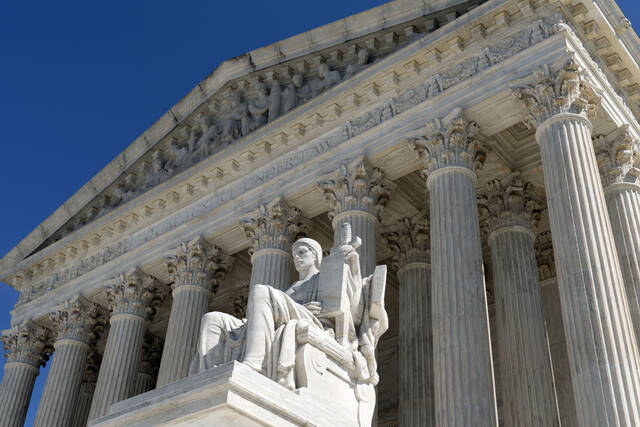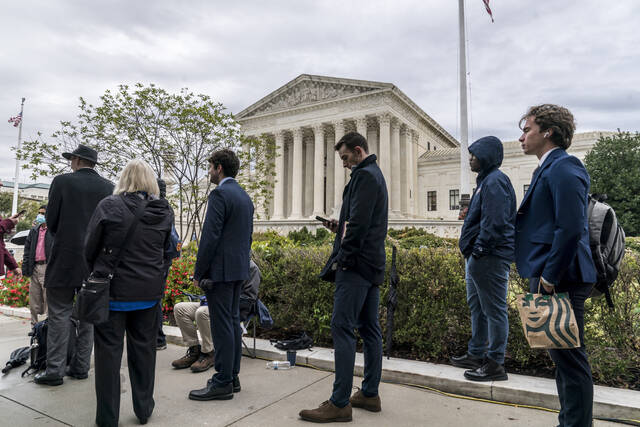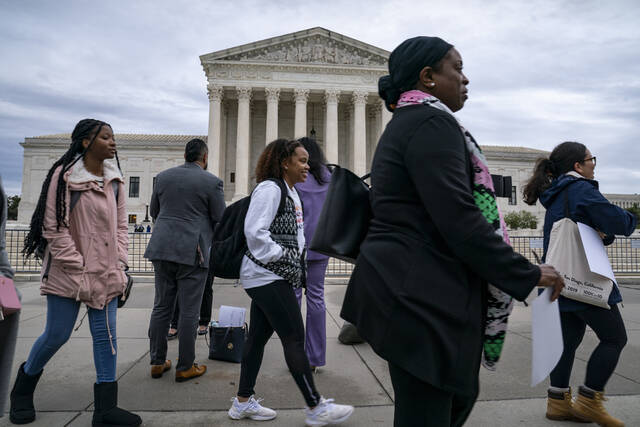Supreme Court welcomes the public again, and a new justice
WASHINGTON — The Supreme Court began its new term Monday with a new justice on the bench, the public back in the courtroom and a spirited debate in a case that pits environmental protections against property rights.
The new member of the court, Justice Ketanji Brown Jackson, wasted no time engaging, asking questions throughout nearly two hours of arguments in the dispute over the nation’s main anti-water pollution law, the Clean Water Act.
Jackson, the court’s first Black female justice, seemed to be generally aligned with the court’s other liberal justices in favor of Justice Department arguments to preserve the authority of the federal government to regulate wetlands under the Clean Water Act against a business-backed challenge.
If Jackson was eager to show she was ready to participate, several conservative justices also provided a quick reminder of the balance of power on a court where they hold a 6-3 majority.
They asked questions that were more skeptical of the regulation in a case that tests the reach of the law beyond rivers, lakes and streams.
One issue in the case is how far wetlands can be from a larger body of water and still be subject to regulation.
Jackson said she wanted to know “why would Congress draw the coverage line between abutting wetlands and neighboring wetlands when the objective of the statute is to ensure the chemical, physical, and biological integrity of the nation’s waters?”
Under an opinion written by retired Justice Anthony Kennedy in 2006, regulators can require permits before allowing development on properties that don’t abut waterways as long as they prove a significant connection to the waterways.
Kennedy, who retired in 2018, was in the courtroom to hear some conservative justices appear to agree with the lawyer for an Idaho couple that Kennedy’s opinion was vague and unworkable.
Chief Justice John Roberts was unsatisfied by Justice Department lawyer Brian Fletcher’s explanation of how to translate Kennedy’s opinion into practice.
“What does that mean?” Roberts asked at one point.
Justices Clarence Thomas, Samuel Alito and Neil Gorsuch, who once was a law clerk to Kennedy, also appeared inclined to side with Chantell and Michael Sackett, who have wanted to build a home close to Priest Lake in Idaho for 16 years and won an earlier round in their legal fight at the Supreme Court.
Monday’s arguments were the first time the justices were back hearing cases since issuing a landmark ruling stripping away women’s constitutional protections for abortion. And for the first time in two and a half years, since the court closed in March 2020 because of the coronavirus pandemic, the public was allowed inside the courtroom, although the court is continuing to provide live audio of arguments on its website.
Because of the pandemic the court is still closed to the public outside of arguments. And two justices wore masks in court Monday: Justice Sonia Sotomayor, who has diabetes and has worn a mask in court consistently during the pandemic, and Justice Elena Kagan, who the court said tested negative for covid-19 but had been exposed to someone with the virus.
A new stack of high-profile cases awaits the justices in the upcoming term. Several cases the court has agreed to hear involve race or elections or both, and the court has also agreed to hear a dispute that returns the issue of free speech and LGBTQ rights to the court.
Also hanging over the justices is some unfinished business from last term: the leak of a draft of the abortion decision seven weeks before it was formally announced. Chief Justice John Roberts ordered an investigation, but the court has yet to provide an update.
Jackson, for her part, has been waiting for months to fully begin her new role since being confirmed in April and sworn in when Justice Stephen Breyer retired in June.
Jackson’s husband, Patrick, and her parents were in the audience Monday, as were the parents of Justice Brett Kavanaugh, and his wife, Ashley.
Jackson joins the court at a time of declining public support for the court. Polls following the court’s abortion decision have shown a sharp drop in the court’s approval rating and in people’s confidence in the court as an institution. A poll over the summer found 43% of Americans saying they have hardly any confidence in the court, up from 27% earlier in the year.
In addition to the abortion ruling, the court also expanded gun rights, reined in the government’s ability to fight climate change and blocked a Biden administration effort to get workers at large companies vaccinated against covid-19.
This term’s significant cases include a struggle over whether Alabama must draw an additional Black majority congressional district, set for arguments Tuesday, and a controversial Republican-led appeal that could dramatically change the way elections for Congress and the presidency are conducted by handing more power to state legislatures. There’s also the case of a Colorado website designer who says her religious beliefs prevent her working with same-sex couples on their weddings. Next month, the justices will hear a challenge to the consideration of race in college admissions.
Remove the ads from your TribLIVE reading experience but still support the journalists who create the content with TribLIVE Ad-Free.






